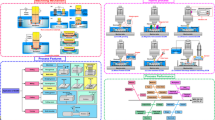Abstract
Electrochemical discharge machining (ECDM) process is a recent non-traditional machining technique used for structuring insulating materials like glass and ceramic substrates. In this work, systematic experimental investigations have been carried out to study the electrical and 2-D machining characteristics of an ECDM process. The influence of various process parameters like electrolyte type, electrolytic concentration, tool travel rate (TTR) and applied voltage on the process characteristics have been studied. Two different electrolytes, i.e., KOH and NaOH with concentrations varying from 10 to 50 % have been used to study their effect on critical voltage (Vc) and critical current (Ic). A cylindrical tungsten carbide tool of diameter 0.4 mm with varying TTRs (ranging from 0.3 to 4 mm/min) and an applied voltage varying from Vc + 2 V to Vc + 5 V is used for realizing microchannels. The influence of these parameters on the quality factors such as geometric accuracy, surface smoothness and channel outlines are explored using the optical images of the machined channels. Experimental results demonstrate that precise channels with smooth surface, and regular channel edges can be obtained at an applied voltage of Vc + 4 V and TTRs between 1 and 2 mm/min.












Similar content being viewed by others
References
Allagui A, Wuthrich R (2011) The electrochemical discharges for the synthesis of nickel oxide nanoparticles: characterization and mechanism. Electrochimic Acta 58:12–18
Almeida FA, Sacramento J, Oliveira FJ, Silva RF (2008) Micro- and nano-crystalline CVD diamond coated tools in the turning of EDM graphite. Surf Coat Tech 203:271–276
Basak I, Ghosh A (1996) Mechanism of spark generation during electrochemical discharge machining: a theoretical model and experimental verification. J Mater Process Tech 62:46–53
Bhattacharyya B, Mitra S, Boro AK (2002) Electrochemical machining: new possibilities for micromachining. Robot Comput Integr Manuf 18:283–289
Choi JP, Jeon BH, Kim BH (2007) Chemical-assisted ultrasonic machining of glass. J Mater Process Technol 191:153–156
Chung CK, Lin SL (2010) CO2 laser micro-machined crackles through holes of Pyrex 7740 glass. Int J Mach Tool Manuf 50:961–968
Crichton IM, Mcgeough JA, Munro W, White C (1981) Comparative studies of ECM, EDM and ECAM. Precis Eng 3:155–160
Esashi M, Matsumoto Y, Shoji S (1990) Absolute pressure sensors by air-tight electrical feedthrough structure. Sensor Actuat A21-A23:1048–1052
Fascio V, Wuthrich R, Viquerat D, Langen H (1999) 3D microstructuring of glass using electrochemical discharge machining (ECDM). Proc Int Symp Micromec Hum Sci. doi:10.1109/MHS.1999.820003
Fascio V, Langen HH, Bleuler H, Comninellis Ch (2003) Investigations of the spark assisted chemical engraving. Electrochem Comm 5:203–207
Fizeau H, Focault L (1844) Research on the intensity of light emitted by carbon on the experience of Davy. Ann Chim Phys 11:370–383
Gautam N, Jain VK (1998) Experimental investigations into ECSD process using various tool kinematics. Int J Mach Tool Manuf 38:15–27
Ghosh A (1997) Ectrochemical discharge machining: principle and possibilities. Sadhana 22:435–447
Ghosh A, Krishna M, Muju T, Parija S, Kanjrathinkal A (1997) Microwelding using electrochemical discharge. Int J Mach Tool Manuf 37:1303–1312
Henry FO, Hoettges KF, Reddy SM, Hughes MP (2007) An integrated dielectrophoretic quartz crystal microbalance (DEP-QCM) device for rapid biosensing applications. Biosens Bioelectron 23:225–232
Iliescu C, Chen B, Miao J (2008) On the wet etching of Pyrex glass. Sensor Actuat A 143:154–161
Jain VK, Adhikary S (2008) On the mechanism of material removal in electrochemical spark machining of quartz under different polarity conditions. J Mater Process Technol 200:40–470
Jana DAZ, Didar TH, Wuthrich R (2012) Micro-texturing channel surfaces on glass with spark assisted chemical engraving. Int J Mach Tool Manuf 57:66–72
Kareem TA, Kaliani A (2012) Glow discharge plasma electrolysis for nanoparticles synthesis. Ionics 18:315–327
Kurafuji H, Suda K (1968) Electrical discharge drilling of glass. Annals CIRP 16:415–419
Lal A, Bleuler H, Wuthrich R (2008) Fabrication of metallic nanoparticles by electrochemical discharges. Electrochem Commun 10:488–491
Lee ES, Howard D, Liang E, Collins SD, Smith RL (2004) Removable tubing interconnects for glass-based micro-fluidic systems made using ECDM. J Micromech Microeng 14:535–541
Mcgeough JA, Khayry ABM, Munro W, Crook (1998) Theoretical and experimental investigation of the relative effects of spark erosion and electrochemical dissolution in electrochemical arc machining. Ann CIRP 32:113–118
Ozhikandathil J, Morrison A, Packirisamy M, Wuthrich R (2011) Low resistive silicon substrate as etch-stop layer for drilling thick SiO2 by spark assisted chemical engraving (SACE). Microsyst Technol 17:373–380
Ravi Sankar A, Bindu VSS, Das S (2011) Coupled effects of gold electroplating and electrochemical discharge machining processes on the performance improvement of a capacitive accelerometer. Microsyst Technol 17(10–11):1661–1670
Saranya S, Ravi Sankar A (2015) Effect of tool shape and tool feed rate on the machined profile of a quartz substrate using an electrochemical discharge machining process. 2nd International Symposium on Physics and Technology of Sensors (ISPTS) doi: 10.1109/ISPTS.2015.7220137
Wuthrich R (2009) Micromacining using electrochemical discharge phenomenon-fundamentals and applications of spark assisted chemical engraving. Elsevier, New York
Wuthrich R, Bleuler H (2004) A model for electrode effects using percolation theory. Electrochim Acta 49:1547–1554
Wuthrich R, Fascio V (2005) Machining of non-conducting materials using electrochemical discharge phenomenon—an overview. Int J Mach Tool Manuf 45:1095–1108
Yamahata C, Lacharme F, Burri Y, Martin AMG (2005) A ball valve micropump in glass fabricated by powder blasting. Sensor Actuat B 110:1–7
Author information
Authors and Affiliations
Corresponding author
Rights and permissions
About this article
Cite this article
Saranya, S., Nair, A. & Ravi Sankar, A. Experimental investigations on the electrical and 2D-machining characteristics of an electrochemical discharge machining (ECDM) process. Microsyst Technol 23, 1453–1461 (2017). https://doi.org/10.1007/s00542-016-3027-8
Received:
Accepted:
Published:
Issue Date:
DOI: https://doi.org/10.1007/s00542-016-3027-8




